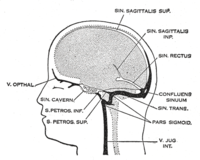
Photo from wikipedia
Background There is uncertainty regarding the predictors of early neurological deterioration (END) after endovascular thrombectomy in patients with acute ischemic stroke (AIS). Limited studies have focused on the effect of… Click to show full abstract
Background There is uncertainty regarding the predictors of early neurological deterioration (END) after endovascular thrombectomy in patients with acute ischemic stroke (AIS). Limited studies have focused on the effect of END on functional outcome. Our aim was to determine the predictors of END after endovascular thrombectomy in AIS and its effect on functional outcome at 90 days. Methods This is a secondary analysis of the DIRECT-MT trial. Patients who failed to complete endovascular thrombectomy were additionally excluded. END was defined as ≥4-point increase in National Institutes of Health Stroke Scale score between admission and 24 hours after endovascular thrombectomy. Multivariable logistic regression was used to identify predictors for END and its effect on the modified Rankin Scale (mRS) score at 90 days. Results Of 591 patients enrolled, 111 (18.8%) had postoperative END, which was associated with higher ordinal mRS score at 90 days (adjusted common OR (aOR) 6.968, 95% CI 4.444 to 10.926). Non-modifiable factors included baseline Alberta Stroke Program Early CT Score (aOR 0.883, 95% CI 0.790 to 0.987), systolic blood pressure (aOR 1.017, 95% CI 1.006 to 1.028), glucose level (aOR 1.178, 95% CI 1.090 to 1.273), collateral status (aOR 0.238, 95% CI 0.093 to 0.608), occlusion site (aOR 0.496, 95% CI 0.290 to 0.851) and the presence of an anterior communicating artery (aOR 0.323, 95% CI 0.148 to 0.707). Admission-to-groin puncture time (aOR 1.010, 95% CI 1.003 to 1.017), general anesthesia (aOR 2.299, 95% CI 1.193 to 4.444), number of passes (aOR 1.561, 95% CI 1.243 to 1.961) and contrast extravasation (aOR 6.096, 95% CI 1.543 to 24.088) were modifiable predictors for END. Conclusions Postoperative END is associated with adverse functional outcome. Several non-modifiable and modifiable factors can predict END and support future treatment decision-making to improve the potential utility of endovascular thrombectomy. Trial registration number DIRECT-MT ClinicalTrials.gov NCT03469206.
Journal Title: Journal of NeuroInterventional Surgery
Year Published: 2022
Link to full text (if available)
Share on Social Media: Sign Up to like & get
recommendations!